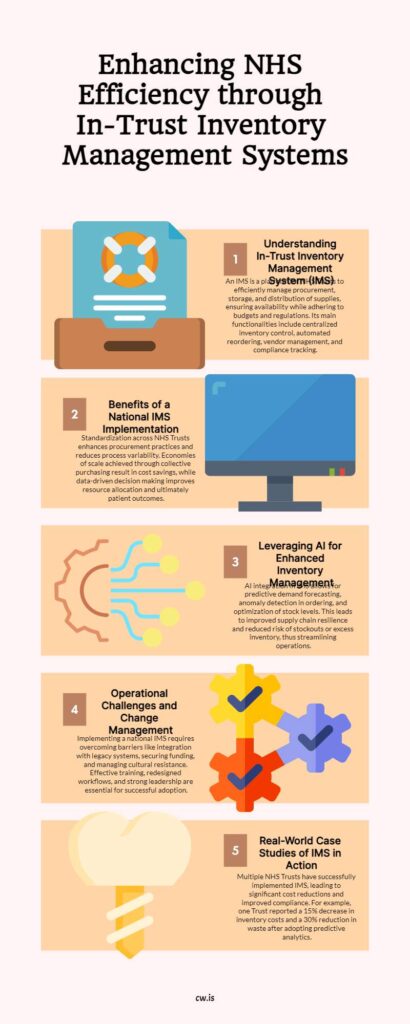Introduction: The Importance of Inventory Management in NHS Trusts
In the ever-evolving landscape of healthcare, managing resources efficiently is critical for delivering high-quality patient care while minimising costs. The National Health Service (NHS) in the United Kingdom, being one of the largest publicly funded healthcare systems globally, faces unique challenges in its supply chain. The role of NHS Trusts, defined as public procurement organisations responsible for delivering healthcare services, is particularly pivotal in managing inventories efficiently. These Trusts are tasked with ensuring that clinical, pharmaceutical, and operational supplies are available when needed, while also adhering to tight budgets and regulatory standards.
A comprehensive In-Trust Inventory Management System (IMS) offers a strategic solution to these challenges. By centralising and streamlining procurement, stock control, and distribution processes, IMS enhances transparency, efficiency, and cost savings. Additionally, the integration of artificial intelligence (AI) into IMS enables insights into purchasing patterns, forecasting demand, and minimising the risk of misordering or stockouts.
This article will explore the core components of an In-Trust Inventory Management System, its strengths, the advantages to supply chain management, and how AI can elevate IMS functionality to provide real-time forecasting, analysis, and cost-saving benefits. We will also discuss how the adoption of IMS aligns with NHS England (NHSE) and NHS Supply Chain’s priorities in improving resource management and patient care outcomes.
1. What is an In-Trust Inventory Management System (IMS)?
An In-Trust Inventory Management System (IMS) is a comprehensive platform used by NHS Trusts to manage the procurement, storage, and distribution of medical, pharmaceutical, and operational supplies. It provides a unified framework for managing all aspects of the inventory lifecycle, from sourcing and procurement to usage and disposal, ensuring that supplies are delivered where and when they are needed most. The main functions of an IMS include:
- Centralised Inventory Control: IMS allows Trusts to maintain a centralised database of stock levels across multiple locations. This provides visibility into current stock status, pending orders, and supply needs in real-time, reducing the risk of overstocking or understocking.
- Automated Reordering: By integrating consumption data, IMS can trigger automated purchase orders when stock reaches predefined thresholds, ensuring timely replenishment.
- Vendor Management: IMS enables Trusts to manage relationships with multiple suppliers, track lead times, and negotiate better terms by analysing past purchase behaviours.
- Compliance and Reporting: Trusts are required to meet stringent regulatory standards related to medical and pharmaceutical supplies. An IMS can track expiration dates, ensure compliance with safety protocols, and generate reports for regulatory authorities.
The overarching goal of an IMS is to ensure that the right materials are available at the right time and in the right quantities, optimising the efficiency of the supply chain while minimising costs.
2. Strengths of Adopting a National In-Trust Inventory Management System
Adopting a standardised national In-Trust IMS across NHS Trusts provides numerous benefits, extending beyond individual organisations to improve overall system efficiency. Key strengths of such a programme include:
2.1 Standardisation Across NHS Trusts One of the most significant advantages of a national IMS programme is the standardisation it brings to procurement and inventory practices. With every NHS Trust operating under the same system, there is a consistent approach to stock control, supplier engagement, and order fulfilment. This reduces variability in processes and ensures that best practices are applied universally.
2.2 Economies of Scale A national IMS allows NHS Trusts to aggregate their purchasing power, leading to bulk purchasing discounts and improved contract terms with suppliers. Centralised negotiation and procurement at scale reduce the unit cost of medical supplies and pharmaceuticals, helping to alleviate financial pressures on Trusts.
2.3 Data-Driven Decision Making A unified national system generates comprehensive data across the entire NHS, enabling advanced analytics on purchasing behaviours, inventory levels, and supply trends. Trusts can use this data to make informed decisions on future procurement needs, which ultimately improves resource allocation and patient outcomes. The data insights generated can also assist in national planning and policy formulation by NHSE and NHS Supply Chain.
2.4 Supply Chain Resilience During times of crisis, such as pandemics or natural disasters, NHS Trusts need to be able to respond quickly and effectively to changing supply demands. A national IMS offers the flexibility and scalability required to manage large-scale stock movements across Trusts, ensuring that supplies can be redistributed to where they are most needed in times of emergency.
2.5 Reduction in Waste Inventory waste, especially with regard to medical supplies and pharmaceuticals that have limited shelf lives, is a major concern. A national IMS provides a clear picture of inventory expiration dates, allowing supplies to be redistributed to other Trusts before they expire, thus reducing wastage. Additionally, accurate stock-level tracking minimises the risk of over-ordering.
2.6 Improved Vendor Relationships Through national contracting, the NHS can form stronger partnerships with key suppliers. A national IMS allows NHS Trusts to monitor vendor performance, track delivery times, and identify opportunities for improvement. This leads to enhanced supplier relationships, fostering trust and accountability.
3. Supply Chain Management Advantages of a Comprehensive IMS
3.1 End-to-End Visibility The core advantage of an IMS lies in providing end-to-end visibility across the entire supply chain. From the moment a product is ordered to its receipt and eventual consumption, Trusts can monitor every step in real-time. This reduces the likelihood of misplaced orders, ensures accurate stock counts, and provides transparency in supply chain operations.
3.2 Optimised Inventory Levels Inventory optimisation is a balancing act—having too much stock ties up resources and creates waste, while too little stock risks critical supply shortages. A comprehensive IMS enables Trusts to maintain optimal inventory levels based on historical consumption data, predictive analytics, and supplier lead times.
3.3 Reduction in Manual Processes Before the introduction of automated IMS solutions, many NHS Trusts relied on manual inventory management processes, which were not only time-consuming but also prone to human error. A modern IMS automates these processes, from procurement to stock count, significantly reducing administrative workloads and increasing accuracy.
3.4 Integration with Procurement and Logistics A fully integrated IMS connects procurement with logistics systems, ensuring that supplies are ordered, delivered, and stocked efficiently. Trusts can manage supplier contracts, purchase orders, delivery schedules, and storage requirements seamlessly through one platform.
3.5 Improved Demand Forecasting One of the most significant challenges faced by NHS Trusts is accurately forecasting demand for medical supplies. Seasonal variations, patient influxes, and unforeseen circumstances can all affect supply requirements. A comprehensive IMS provides demand forecasting tools that use historical data and real-time consumption rates to predict future stock needs, reducing the risk of stockouts or over-ordering.
3.6 Enhanced Collaboration Across Trusts IMS platforms offer opportunities for cross-Trust collaboration. In cases where one Trust faces supply shortages, the IMS allows them to quickly identify another Trust with surplus stock, facilitating inter-Trust transfers that help prevent supply disruptions.
4. Leveraging Artificial Intelligence in In-Trust IMS
The integration of artificial intelligence (AI) into IMS can revolutionise the way NHS Trusts manage their inventories by providing actionable insights, demand forecasting, and anomaly detection. Here are several ways AI can elevate IMS functionality:
4.1 Predictive Demand Forecasting AI algorithms can analyse vast amounts of historical data, patient demographics, seasonal trends, and even external factors like pandemics to predict future inventory needs. By using machine learning models, AI can learn from past patterns to anticipate future demand, allowing Trusts to maintain ideal stock levels at all times.
4.2 Preventing Misordering and Stockouts One of the key pain points for NHS Trusts is the risk of misordering, which can result in stockouts or surplus inventory. AI-powered systems can detect anomalies in ordering patterns and flag potential issues before they escalate. For example, if a sudden spike in orders for a particular item is detected, the AI can alert procurement teams to verify the validity of the order.
4.3 Optimising Stock Levels AI can identify inefficient inventory practices, such as overstocking certain items while understocking others. By continuously analysing stock movement and usage data, AI can provide recommendations on how to adjust stock levels to better meet demand. This leads to better resource allocation and lower carrying costs.
4.4 Enhanced Supply Chain Resilience AI can be used to simulate different supply chain scenarios and develop contingency plans. By modelling the potential impact of supplier disruptions, sudden surges in demand, or logistical challenges, AI helps Trusts build more resilient supply chains that can adapt to changing circumstances quickly.
4.5 Reducing Human Error AI-powered IMS can automate repetitive tasks, such as data entry, order creation, and stock reconciliations, reducing the risk of human error and freeing up healthcare staff to focus on more critical tasks. Furthermore, AI can provide real-time decision support by suggesting optimal reordering schedules based on dynamic variables like demand fluctuations and lead times.
5. Alignment with NHS England and NHS Supply Chain Priorities
The adoption of a national IMS aligns directly with several key priorities set out by NHS England (NHSE) and NHS Supply Chain, including:
5.1 Improving Operational Efficiency NHSE has prioritised the need for NHS Trusts to operate more efficiently, reducing unnecessary costs while maintaining high standards of patient care. A national IMS helps achieve this goal by streamlining inventory management, reducing waste, and optimising procurement practices.
5.2 Ensuring Supply Chain Resilience The COVID-19 pandemic highlighted the vulnerability of supply chains, particularly in the healthcare sector. NHS Supply Chain’s focus on building more resilient and agile supply chains can be supported through a comprehensive IMS, which provides real-time data visibility, demand forecasting, and contingency planning
, enabling NHS Trusts to respond quickly and effectively to disruptions. By ensuring that critical supplies are available when and where they are needed, a robust IMS mitigates the risk of supply chain failures during emergencies or unexpected demand surges.
5.3 Supporting Sustainability Initiatives Sustainability is increasingly becoming a priority within the NHS. In alignment with NHS England’s long-term plan to reduce the environmental impact of its operations, a national IMS can contribute to sustainability goals by minimising waste and optimising procurement practices. By reducing over-ordering and managing stock more efficiently, the system helps limit the amount of excess inventory that might otherwise expire and need disposal, thus contributing to the NHS’s carbon reduction targets.
5.4 Driving Data-Driven Decision Making NHS England and NHS Supply Chain have emphasised the importance of using data to inform decision-making and drive operational improvements. An IMS equipped with advanced analytics and AI capabilities provides Trusts with real-time, actionable insights that support more informed and timely decisions. This can lead to better outcomes, such as reduced costs, improved patient care, and enhanced supply chain performance.
5.5 Enhancing Collaboration Across the NHS The NHS is a vast and interconnected system, and fostering collaboration between different NHS Trusts is critical to its success. A national IMS facilitates greater collaboration by providing shared visibility into inventory levels across Trusts, enabling resource-sharing, and creating opportunities for joint procurement initiatives. This collaborative approach can lead to better resource utilisation, lower costs, and more consistent supply chain performance across the entire NHS.
6. Practical Examples of IMS and AI Implementation in NHS Trusts
Several NHS Trusts have already begun leveraging IMS solutions to optimise their supply chains, with promising results. Below are a few real-world examples that demonstrate the potential impact of a comprehensive IMS and AI integration:
6.1 Case Study: Stock Optimisation at a Large NHS Trust One NHS Trust implemented an advanced IMS that featured predictive analytics to optimise stock levels for medical supplies. Before implementation, the Trust struggled with frequent stockouts and over-ordering, leading to supply shortages in critical areas and wasted resources elsewhere. After implementing the IMS, the Trust saw a significant improvement in its ability to forecast demand, which resulted in a 15% reduction in overall inventory costs and a 30% reduction in waste from expired products.
6.2 Case Study: AI-Enhanced Reordering in a Regional NHS Trust A regional NHS Trust introduced an AI-powered IMS to help with automatic reordering of pharmaceuticals and medical devices. The system used machine learning algorithms to predict future demand based on historical usage patterns, patient demographics, and seasonal factors. As a result, the Trust experienced fewer stockouts, improved order accuracy, and saved 10% on procurement costs within the first year of implementation.
6.3 Case Study: Improved Compliance Through IMS Integration In another example, an NHS Trust implemented a comprehensive IMS with AI capabilities to track compliance with regulatory requirements related to pharmaceutical and medical supplies. The system was able to automatically flag products that were nearing their expiration dates and ensure they were used before new stock was ordered. This helped the Trust maintain compliance with NHS England’s safety standards while reducing waste and the risk of using expired supplies.
7. The Role of Change Management in IMS Adoption
Implementing a national IMS is not just about technology; it requires a significant cultural shift within NHS Trusts. Change management plays a vital role in ensuring the successful adoption and integration of a new IMS. Trusts must be prepared to train their staff on new systems, redesign workflows, and adjust procurement practices to fully realise the benefits of IMS.
7.1 Training and Education Training healthcare professionals and procurement staff to use an IMS is critical for its success. Staff must understand the system’s features and how it integrates with their day-to-day tasks. In addition, as AI and predictive analytics become more prevalent in IMS platforms, staff will need training in interpreting the insights these tools provide.
7.2 Redesigning Procurement Processes The introduction of an IMS often requires Trusts to redesign their procurement processes to align with the system’s capabilities. For example, procurement teams may need to shift from reactive purchasing to proactive, data-driven purchasing based on the system’s demand forecasts and stock optimisation recommendations.
7.3 Change Leadership Leadership buy-in is essential for successful IMS adoption. Leaders within NHS Trusts must champion the system’s benefits and provide support to staff during the transition. Clear communication from leadership can help alleviate concerns about the change and encourage staff to embrace the new system.
8. Overcoming Barriers to IMS Implementation
While the benefits of a national IMS are clear, NHS Trusts may face certain barriers to implementation. Common challenges include:
8.1 Integration with Legacy Systems Many NHS Trusts already have existing systems in place for procurement and inventory management, which may not be fully compatible with a new IMS. Ensuring seamless integration between new and legacy systems can be a technical and logistical challenge, but it is crucial for ensuring continuity of operations.
8.2 Initial Costs and Funding Implementing a national IMS requires upfront investment in technology, infrastructure, and training. While the long-term cost savings are significant, some Trusts may struggle to secure the necessary funding for initial implementation. However, national initiatives and funding support from NHS England and NHS Supply Chain can help offset these costs.
8.3 Resistance to Change Cultural resistance is another common barrier. Staff who are accustomed to manual or legacy processes may be hesitant to adopt new systems. Overcoming this resistance requires clear communication, strong leadership, and comprehensive training to ensure that staff understand the benefits of the new system.
9. Conclusion: The Future of IMS and AI in NHS Trusts
In-Trust Inventory Management Systems represent a significant opportunity for NHS Trusts to improve supply chain efficiency, reduce costs, and enhance patient care. By centralising inventory management, standardising procurement practices, and leveraging AI for predictive analytics, IMS enables Trusts to optimise their operations and better respond to the needs of the healthcare system.
The integration of AI into IMS adds a layer of intelligence that allows Trusts to forecast demand, prevent misordering, and gain real-time insights into supply chain performance. This not only improves operational efficiency but also aligns with NHS England and NHS Supply Chain’s goals of improving resource management, ensuring supply chain resilience, and reducing waste.
As NHS Trusts continue to face growing pressures to deliver high-quality patient care while managing tight budgets, the adoption of a national IMS is a crucial step toward building a more efficient, data-driven, and sustainable healthcare system. By embracing IMS and AI, NHS Trusts can enhance their ability to meet current and future challenges, ensuring that they are well-positioned to provide excellent care to patients across the UK.
In conclusion, an In-Trust IMS is not just a tool for managing inventory; it is a strategic asset that can transform the way NHS Trusts operate, enabling them to deliver better care at a lower cost while aligning with national healthcare priorities.
- NHS England Long Term Plan (2019)
https://www.longtermplan.nhs.uk/
- NHS England Long Term Plan (2019)
- Topol Review (2019) – Preparing the healthcare workforce to deliver the digital future
https://topol.hee.nhs.uk/ - Managing healthcare supply chain through artificial intelligence (AI): A study of critical success factors – PMC (nih.gov)
- NHS Supply Chain Inventory Management Systems (IMS)In-Trust Inventory Management Systems (IMS) » NHS Supply Chain

This article is an independent analysis and is not affiliated with, nor does it reflect the views of, any ongoing programmes or initiatives currently being undertaken by NHS England, NHS Supply Chain, or any other healthcare organisation. The content presented here is for informational purposes only and is based on publicly available information at the time of writing. It does not constitute official guidance, endorsement, or recommendations from any specific NHS Trust or healthcare body.








